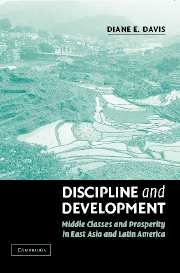Book contents
- Frontmatter
- Contents
- Preface
- DISCIPLINE AND DEVELOPMENT
- 1 An Introduction to Middle Classes, Discipline, and Development
- 2 Middle Classes and Development Theory
- 3 Discipline and Reward: Rural Middle Classes and the South Korean Development Miracle
- 4 Disciplinary Development as Rural Middle-Class Formation: Proletarianized Peasants and Farmer-Workers in Argentina and Taiwan
- 5 From Victors to Victims? Rural Middle Classes, Revolutionary Legacies, and the Unfulfilled Promise of Disciplinary Development in Mexico
- 6 Disciplinary Development in a New Millennium: The Global Context of Past Gains and Future Prospects
- Appendix A Cases, Comparisons, and a Note on Methodology and Sources
- Appendix B Defining the Middle Class: Notes on Boundaries and Epistemology
- Appendix C Tables
- Bibliography
- Index
5 - From Victors to Victims? Rural Middle Classes, Revolutionary Legacies, and the Unfulfilled Promise of Disciplinary Development in Mexico
Rural middle classes, revolutionary legacies, and the unfulfilled promise of disciplinary development in mexico
Published online by Cambridge University Press: 31 July 2009
- Frontmatter
- Contents
- Preface
- DISCIPLINE AND DEVELOPMENT
- 1 An Introduction to Middle Classes, Discipline, and Development
- 2 Middle Classes and Development Theory
- 3 Discipline and Reward: Rural Middle Classes and the South Korean Development Miracle
- 4 Disciplinary Development as Rural Middle-Class Formation: Proletarianized Peasants and Farmer-Workers in Argentina and Taiwan
- 5 From Victors to Victims? Rural Middle Classes, Revolutionary Legacies, and the Unfulfilled Promise of Disciplinary Development in Mexico
- 6 Disciplinary Development in a New Millennium: The Global Context of Past Gains and Future Prospects
- Appendix A Cases, Comparisons, and a Note on Methodology and Sources
- Appendix B Defining the Middle Class: Notes on Boundaries and Epistemology
- Appendix C Tables
- Bibliography
- Index
Summary
Beyond Regime Type
If we were to choose just one other twentieth-century developer whose surface political profile most nearly parallels that of Taiwan, Mexico would be a principal contender. Both Mexico and Taiwan have been known over the past half century for their strong and enduring systems of one-party rule, fortified through forceful political, ideological, and institutional connections between a vanguard revolutionary party and the state. Both of these countries' party-state apparatuses, the KMT and Mexico's Partido Revolucionario Institucional (PRI), were highly centralized and carefully structured around corporatist principles that mandated the institutional inclusion of a wide variety of class forces drawn from both rural and urban locales. Additionally, the long-term trajectories of political development in both countries are quite similar on many counts, including the timing of democratic opening in the late 1980s and the role played by grassroots democratic movements in bringing this political change. In Taiwan, it was the end of martial law in 1987 that marked the key point of democratic transition, while in Mexico this was the same year that opposition candidate Cuauhtémoc Cárdenas broke from the PRI, ran for the presidency on his own, and started Mexico down its current path toward democratic consolidation. Yet despite these political similarities, the economic development trajectories of these two countries over the last half century have diverged considerably.
- Type
- Chapter
- Information
- Discipline and DevelopmentMiddle Classes and Prosperity in East Asia and Latin America, pp. 245 - 339Publisher: Cambridge University PressPrint publication year: 2004



